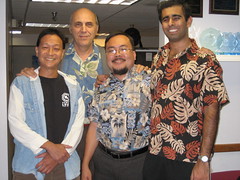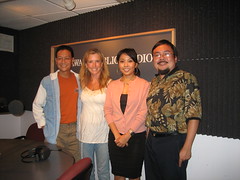 This week after the news, we speak with Laurie Gerber, Board member of the Association for Machine Translation in the Americas, who tells us about an upcoming Machine Translation conference. Then, we’re joined in the studio by Rob Farrow to discuss social networks, online identity, OpenID, and Chi.mp. This week’s song pick is inspired by Chi.mp: “Code Monkey” by Jonathan Coulton.
This week after the news, we speak with Laurie Gerber, Board member of the Association for Machine Translation in the Americas, who tells us about an upcoming Machine Translation conference. Then, we’re joined in the studio by Rob Farrow to discuss social networks, online identity, OpenID, and Chi.mp. This week’s song pick is inspired by Chi.mp: “Code Monkey” by Jonathan Coulton.
In the News…
- A team of astronomers has identified the least luminous galaxy known, but found it is surprisingly massive. Using the Keck Observatories up on Mauna Kea, Marla Geha, an assistant professor of astronomy at Yale University along with her colleague Josh Simon at the California Institute of Technology, has observed about half of the two dozen dwarf satellite galaxies that orbit the Milky Way.
- At the University of Hawaii, chemists traded their lab coats for surf shorts, breaking out of the lab to test their theories on the waves. UH chemistry professor Robert Liu and his colleagues found that local surf spots provided ideal conditions to study photochemical reactions, and by building a special boogie board with a test-tube mounted in it, they were able to use the sun’s rays to make variants of vitamin A.
- Dana Slaymaker of Resource Mapping Hawaii developed a camera system that can map thousands of acres by airplane with images so detailed that tree leaves can be identified. The development of this technology is expected to revolutionize conservation work in Hawaii and around the world.
- Increasing demand and a changing climate have led to the collapse of several once-rich fisheries around the world, and many are still in danger. Regional overfishing can lead to extinctions of native fish species, and in the long term, huge shortfalls in the food supply for millions. Around the world, policymakers, environmentalists, and fishermen have been searching for a solution. And a university of Hawaii economist — along with colleagues at the University of California at Santa Barbara — say one controversial solution may have merit.


